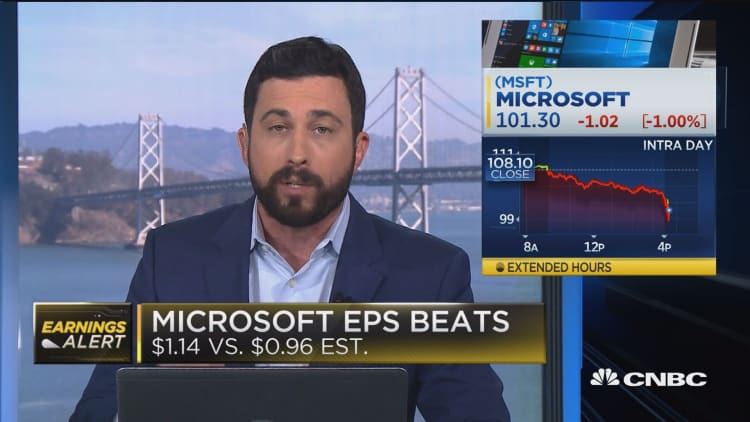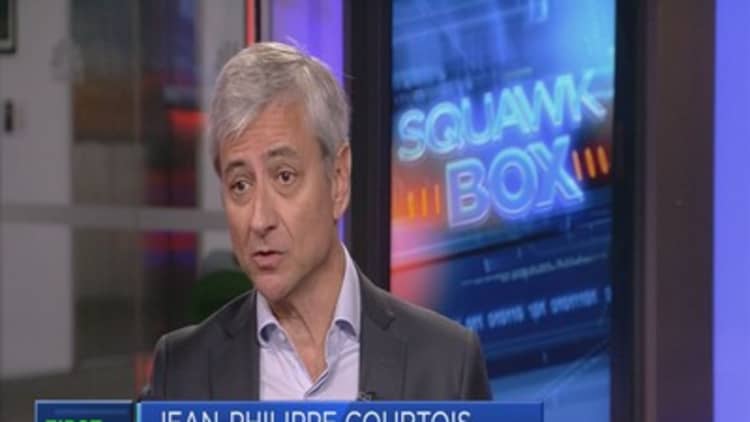
Microsoft stock rose as much as 4 percent above the $102.32 closing price on Wednesday after the company reported better-than-expected earnings for its fiscal first quarter.
Here are the key numbers:
- Earnings: $1.14 per share, excluding certain items, vs. $0.96 per share as expected by analysts, according to Refinitiv.
- Revenue: $29.08 billion, vs. $27.90 billion as expected by analysts, according to Refinitiv.
The stock lost some of its post-earnings gain after Microsoft presented guidance for the fiscal second quarter. Microsoft chief financial officer Amy Hood told analysts on Wednesday's earnings call that the company expects $31.9 billion to $32.7 billion in revenue in the fiscal second quarter, including a contribution from GitHub, an acquisition that has not closed yet. Analysts had been expecting a total of $32.25 billion in revenue, according to Refinitiv.
Microsoft's revenue rose 19 percent year over year overall in the fiscal first quarter, according to a statement. Analysts polled by Refinitiv had been modeling 13.7 percent growth -- just under the 14 percent growth Microsoft had across its entire 2018 fiscal year.
Microsoft continues to emphasize the growth from its business-focused cloud services, which are tracked under the Commercial Cloud revenue metric. The company is challenging public cloud market leader Amazon Web Services with its Azure business, adding business users for its Office 365 cloud productivity app portfolio that competes with Alphabet's Google G Suite and seeking to take market share from Salesforce with its Dynamics 365 software.
What's different now is that Microsoft is starting to include commercial LinkedIn revenue, which includes products like LinkedIn Recruiter, in the Commercial Cloud tally. In a presentation to investors last month, Microsoft showed how adding commercial LinkedIn to Commercial Cloud revenue for the 2018 fiscal year would bump up the total by about $3.4 billion, reflecting an increase approaching 15 percent.
Commercial Cloud ultimately came in at $8.5 billion, up 47 percent year over year. Syed Talha Saleem, equity research associate at Credit Suisse, told CNBC in an email that he was expecting Commercial Cloud to hit $8.3 billion in revenue.
Azure's revenue was up 76 percent, slipping from 89 percent growth one quarter ago. The Azure performance was in line with Microsoft's expectations, Microsoft chief financial officer Amy Hood said on a conference call with analysts after the earnings release.
In recent days a few analysts indicated they were expecting an Azure growth slowdown. In a distributed to clients on Sunday Evercore ISI analysts led by Kirk Materne predicted 78 percent growth. Timothy Horan, senior analyst at Oppenheimer, attributed the slowdown to the law of large numbers. (Amazon's cloud business is growing more slowly, at 49 percent in the second quarter on a larger base of $6.11 billion in revenue.)
"While this level of deceleration may seem overly cautious given the momentum behind Azure in the market, we believe it is instructive for investors to understand that much of this deceleration is due to the leveling off of growth for the company's Enterprise Mobility & Security (EMS) products, which are seat based, vs. any major deceleration in the IaaS/PaaS offerings," the Evercore analysts wrote.
Microsoft hasn't disclosed how much revenue Azure brings in, but the Evercore analysts estimated that it generated more $7.74 billion in the 2018 fiscal year. At that size, Azure would have accounted for 7 percent of Microsoft's total annual revenue.
The company's biggest business segment, More Personal Computing -- which includes Windows, devices, gaming and search ads -- fetched $10.7 billion in revenue, up 15 percent. The segment came in above the FactSet consensus estimate of $10.18 billion.
The Productivity and Business Processes segment, which includes Office, Dynamics and LinkedIn, did $9.8 billion in revenue, which was up 19 percent and ahead of the FactSet consensus estimate of $9.39 billion. The company had 32.5 million Office 365 consumer subscribers in the fiscal first quarter, up sequentially from 31.4 million.
Microsoft's Intelligent Cloud segment, containing server products and cloud services (including Azure) along with consulting and support, grew 24 percent with $8.6 billion in revenue. The results exceeded the $8.29 billion FactSet estimate. In the quarter Microsoft logged $4.3 billion in capital expenditures, up 59 percent year over year. Capital expenditures rose 33 percent in the 2018 fiscal year.
"No customer wants to be dependent on a provider that sells them technology on one end and competes with them on the other," Microsoft CEO Satya Nadella said on the conference call.
Microsoft's stock fell more than 5 percent ahead of the earnings release on Wednesday, in its worst day of trading since Oct. 10. The stock is down almost 11 percent in the past month, but it's still up almost 20 percent since the beginning of the year.
In the fiscal first quarter, Microsoft acquired Lobe and introduced a free tier of its Teams app, and Nadella sold around 30 percent of his common stock.
CNBC's Fred Imbert and Josh Lipton contributed to this report.
WATCH: Microsoft exec: Want to enable any company to be a digital business



